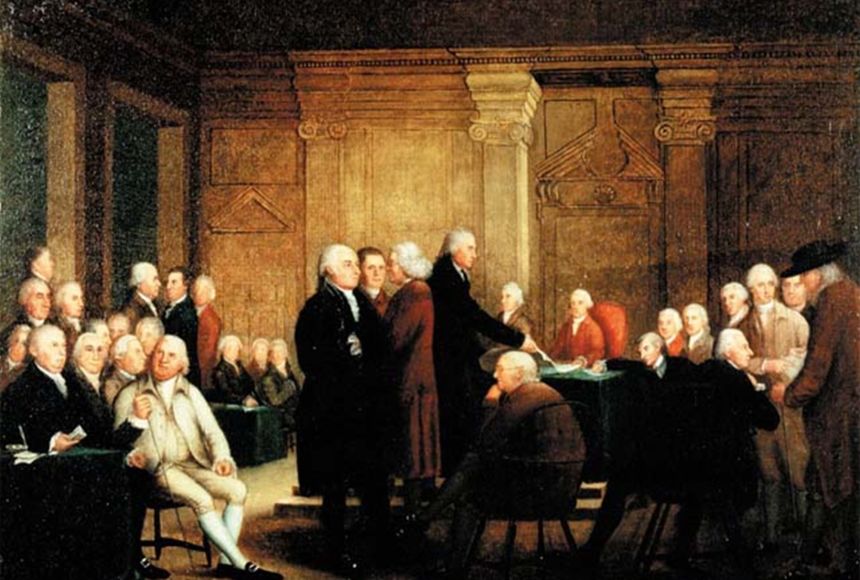The most famous printed version of the Declaration of Independence is emblazoned with the words "In Congress, July 4, 1776" at the top. It displays the signatures of John Hancock and other founders at the bottom. Interestingly, this document was not officially signed on that celebrated date. The document, central to founding the United States of America, was created through a process that took time, cooperation, and revision. Its history deserves a closer look.
Beginning Drafts of the Declaration
In May of 1775, the Second Continental Congress was seated in the Assembly Hall of the Pennsylvania State House in Philadelphia. Weeks earlier, hostilities had broken out between the British and colonial militias in Massachusetts. The British king had ignored the petition sent the prior October by the First Continental Congress, stating the colonists' frustrations. In August of 1775, the king declared the colonies to be rebels. The Second Congress swiftly formed a Continental Army under the command of George Washington. By the middle of 1776, public support grew throughout the colonies in favor of independence from Great Britain.
On June 7, 1776, a Virginia delegate named Henry Lee, acting on behalf of the Virginia Convention, proposed a resolution in Congress. This resolution for independence stated that the "United Colonies" had the right to be free and independent states. It also declared that the colonies should be free from allegiance to the British Crown. Lastly, it stated that all political connection to Britain should be totally dissolved. Other town and colonial assemblies were issuing similar pleas.
Such a strong action demanded careful deliberation. On June 11, Congress organized a process to clarify a vote on the resolution. It appointed a five-member committee to draft a public statement that would further explain the reasons for declaring independence should Congress decide to do so. John Adams of Massachusetts and Benjamin Franklin of Pennsylvania were on the committee. Robert R. Livingston of New York and Roger Sherman of Connecticut were also appointed. The fifth member, Virginian Thomas Jefferson, was chosen to be the document's principal drafter. After incorporating changes suggested by Adams and Franklin, the committee submitted its draft declaration to the Congress on June 28. This is the scene illustrated in a famous painting that now hangs in the Capitol Building rotunda in Washington, D.C.
Congress debated the resolution on Monday, July 1. Nine colonies were prepared to vote in favor. The South Carolina and Pennsylvania delegations were opposed. Two Delaware delegates were deadlocked and the New York delegates were unable to vote, since their instruction permitted them only to cooperate with the king. Overnight, however, the situation changed. On July 2, Caesar Rodney rode in to Philadelphia from Dover, Delaware, bringing a tie-breaking vote for Delaware in favor of independence. South Carolina shifted its position in favor, and the Pennsylvania opponents chose to stay away. When the vote was called on July 2, the resolution passed by a vote of 12 to zero, with New York abstaining. After this historic decision, John Adams wrote to his wife, Abigail, predicting that future Americans would mark their independence with a festival every second of July.
Further Edits and First Printing
Fueled by the growing threat of violence with British troops, the full Congress then began debating the declaration. They began making significant edits while leaving Jefferson's passionately written opening paragraphs. On July 4, Congress approved the final draft and ordered it to be printed.
That evening, the printer was prepared for a complete text of "a Declaration by the Representatives of the United States of America, in General Congress assembled." It is believed that about 200 copies were published on July 5 and only about 25 still exist today. The document was signed by John Hancock. It was read aloud in front of the statehouse in Philadelphia on July 8. Over the next few weeks it was reprinted in newspapers up and down the Atlantic seaboard.
On July 9, New York joined the other colonies favoring a formal break with Britain. A few days later, the news reached Philadelphia that the colonies were united upon independence. On July 19, Congress ordered an official copy of the declaration on parchment for the delegates to sign.
Signing the Declaration
On August 2, 1776, the Congress members placed their signatures to this parchment inside the Pennsylvania State House. Not every man who had been present on July 4 signed the declaration on August 2. Two prominent delegates passed up the chance to sign and others were added later. The first and largest signature was that of the president of the Congress, John Hancock. The mood in the room was far from jubilant. All were aware of what they were undertaking. It was an act of high treason against the British Crown that could cost each man his life. Recalling the day many years later, Benjamin Rush, a signer of the Declaration of Independence and a leader in Philadelphia, wrote of the tense "and awful silence which pervaded the house when we were called up, one after another, to the table of the President of Congress," to sign "what was believed by many at that time to be our own death warrants."

